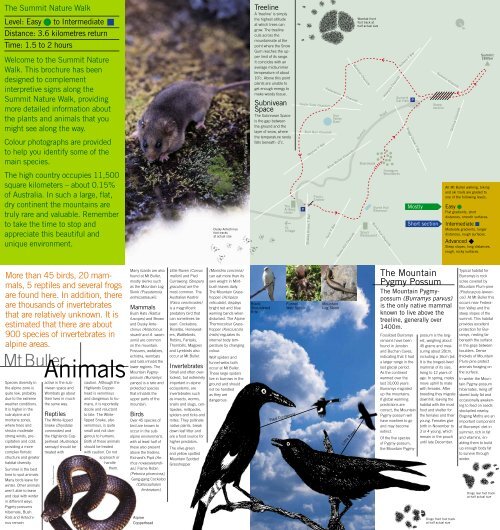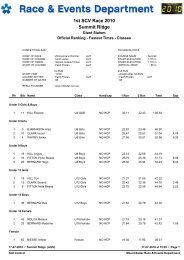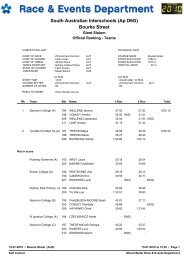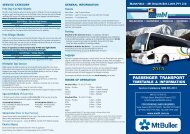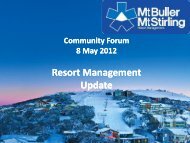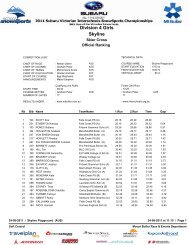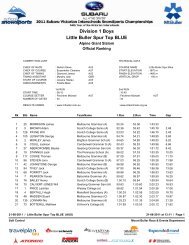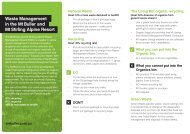Vegetation - Mt Buller
Vegetation - Mt Buller
Vegetation - Mt Buller
Create successful ePaper yourself
Turn your PDF publications into a flip-book with our unique Google optimized e-Paper software.
The Summit Nature Walk<br />
Level: Easy to Intermediate<br />
Distance: 3.6 kilometres return<br />
Time: 1.5 to 2 hours<br />
Welcome to the Summit Nature<br />
Walk. This brochure has been<br />
designed to complement<br />
interpretive signs along the<br />
Summit Nature Walk, providing<br />
more detailed information about<br />
the plants and animals that you<br />
might see along the way.<br />
Colour photographs are provided<br />
to help you identify some of the<br />
main species.<br />
The high country occupies 11,500<br />
square kilometers – about 0.15%<br />
of Australia. In such a large, flat,<br />
dry continent the mountains are<br />
truly rare and valuable. Remember<br />
to take the time to stop and<br />
appreciate this beautiful and<br />
unique environment.<br />
More than 45 birds, 20 mammals,<br />
5 reptiles and several frogs<br />
are found here. In addition, there<br />
are thousands of invertebrates<br />
that are relatively unknown. It is<br />
estimated that there are about<br />
900 species of invertebrates in<br />
alpine areas.<br />
<strong>Mt</strong> <strong>Buller</strong><br />
Species diversity in<br />
the alpine zone is<br />
quite low, probably<br />
due to the extreme<br />
weather conditions.<br />
It is higher in the<br />
sub-alpine and<br />
montane zones,<br />
where trees and<br />
shrubs moderate<br />
strong winds, precipitation<br />
and cold,<br />
providing a more<br />
complex floristic<br />
structure and greater<br />
habitat diversity.<br />
Summer is the best<br />
time to spot animals.<br />
Many birds leave for<br />
winter. Other animals<br />
aren’t able to leave<br />
and deal with winter<br />
in different ways.<br />
Pygmy-possums<br />
hibernate, Bush<br />
Rats and Antechinus<br />
remain<br />
Animals<br />
active in the subnivean<br />
space and<br />
Wombats go about<br />
their lives in much<br />
the same way.<br />
Reptiles<br />
The White-lipped<br />
Snake (Drysdalia<br />
coronoides) and<br />
the Highlands Copperhead<br />
(Austrelaps<br />
ramsayi) should be<br />
treated with<br />
Photo:Raymond Hoser<br />
caution. Although the<br />
Highlands Copperhead<br />
is venomous<br />
and dangerous to humans,<br />
it is reportedly<br />
docile and reluctant<br />
to bite. The Whitelipped<br />
Snake, also<br />
venomous, is quite<br />
small and not dangerous<br />
to humans.<br />
Both of these animals<br />
should be treated<br />
with caution. Do not<br />
approach or<br />
handle<br />
them.<br />
Many lizards are also<br />
found at <strong>Mt</strong> <strong>Buller</strong>,<br />
mostly skinks such<br />
as the Mountain Log<br />
Skink (Pseudemoia<br />
entrecasteauxii).<br />
Mammals<br />
Bush Rats (Rattus<br />
fuscipes) and Brown<br />
and Dusky Antechinus<br />
(Antechinus<br />
stuartii and A. swainsonii)<br />
are common<br />
on the mountain.<br />
Possums, wallabies,<br />
echidna, wombats<br />
and bats inhabit the<br />
lower regions. The<br />
Mountain Pygmypossum<br />
(Burramys<br />
parvys) is a rare and<br />
protected species<br />
that inhabits the<br />
upper parts of the<br />
mountain.<br />
Birds<br />
Over 45 species of<br />
bird are known to<br />
occur in the subalpine<br />
environment,<br />
with at least half of<br />
these also present<br />
above the treeline.<br />
Richard’s Pipit (Anthusnovaeseelandiae),<br />
Flame Robin<br />
(Petroica phoenicea),<br />
Gang-gang Cockatoo<br />
(Callocephalon<br />
fimbriatum),<br />
Alpine<br />
Copperhead<br />
Little Raven (Corvus<br />
mellori) and Pied<br />
Currawong (Strepera<br />
graculina) are the<br />
most common. The<br />
Australian Kestrel<br />
(Falco cenchroides)<br />
is a magnificent<br />
predatory bird that<br />
can sometimes be<br />
seen. Cockatoos,<br />
Rosellas, Honeyeaters,<br />
Wattlebirds,<br />
Robins, Fantails,<br />
Thornbills, Magpies<br />
and Lyrebirds also<br />
occur at <strong>Mt</strong> <strong>Buller</strong>.<br />
Invertebrates<br />
Small and often overlooked,<br />
but extremely<br />
important in alpine<br />
ecosystems, are<br />
invertebrates such<br />
as insects, worms,<br />
snails and slugs, centipedes,<br />
millipedes,<br />
spiders and ticks and<br />
mites. They pollinate<br />
native plants, break<br />
down leaf litter and<br />
are a food source for<br />
higher predators.<br />
The olive green<br />
and yellow spotted<br />
Mountain Spotted<br />
Grasshopper<br />
Dusky Antechinus<br />
foot tracks<br />
at actual size<br />
(Monistria concinna)<br />
can eat more than its<br />
own weight in Mintbush<br />
leaves daily.<br />
The Mountain Grasshopper<br />
(Acripeza<br />
reticulata), displays<br />
bright red and blue<br />
warning bands when<br />
disturbed. The Alpine<br />
Thermocolour Grasshopper<br />
(Kosciuscola<br />
tristis) regulates its<br />
internal body temperature<br />
by changing<br />
colour.<br />
Wolf spiders and<br />
funnel-webs both<br />
occur at <strong>Mt</strong> <strong>Buller</strong>.<br />
These large spiders<br />
live in burrows in the<br />
ground and should<br />
not be handled<br />
as they are<br />
dangerous.<br />
Mountain Pygmy-possum<br />
Treeline<br />
A ‘treeline’ is simply<br />
the highest altitude<br />
at which trees can<br />
grow. The treeline<br />
cuts across the<br />
mountainside at the<br />
point where the Snow<br />
Gum reaches the upper<br />
limit of its range.<br />
It coincides with an<br />
average midsummer<br />
temperature of about<br />
10˚c. Above this point<br />
plants are unable to<br />
get enough energy to<br />
make woody tissue.<br />
Subnivean<br />
Space<br />
The Subnivean Space<br />
is the gap between<br />
the ground and the<br />
layer of snow, where<br />
the temperature rarely<br />
falls beneath -2˚c.<br />
Black<br />
Shouldered<br />
Kite<br />
The<br />
Arlberg<br />
Hotel<br />
To<br />
Village<br />
Pied Currawong<br />
Funnel<br />
Web Spider<br />
South Side Chairlift<br />
Bull Run Chairlift<br />
Shakey Knees T Bar<br />
Skyline T Bar<br />
Picnic<br />
Shelter<br />
Federation Chairlift<br />
Sun<br />
Valley<br />
Dam<br />
Blue Bullet Chairlift<br />
Tyrol T Bar<br />
Mountain<br />
Log Skink<br />
Horse Hill Chairlift<br />
Little Raven<br />
Wombat front<br />
foot track at<br />
half actual size<br />
Wombat Chairlift<br />
Summit<br />
Boardwalk<br />
Spurs<br />
Restaurant<br />
Road<br />
Burnt Hut<br />
Reservoir<br />
Burnt Hut Chairlift<br />
Howqua Chairlift<br />
Snowgum<br />
Woodlands<br />
Koflers T Bar<br />
Summit<br />
Car Park<br />
Boggy Creek T Bar<br />
Mostly<br />
The Mountain<br />
Pygmy Possum<br />
The Mountain Pygmypossum<br />
(Burramys parvus)<br />
is the only native mammal<br />
known to live above the<br />
treeline, generally over<br />
1400m.<br />
Fossilized Burramys<br />
remains have been<br />
found in Jenolan<br />
and Buchan Caves,<br />
indicating that it had<br />
a larger range in the<br />
last glacial period.<br />
As the continent<br />
warmed over the<br />
last 10,000 years<br />
Burramys migrated<br />
up the mountains.<br />
If global warming<br />
predictions are<br />
correct, the Mountain<br />
Pygmy-possum will<br />
have nowhere to go<br />
and may become<br />
extinct.<br />
Of the five species<br />
of Pygmy-possum,<br />
the Mountain Pygmy-<br />
Summit Chairlift<br />
Steep<br />
section<br />
Short section<br />
possum is the largest,<br />
weighing about<br />
45 grams and measuring<br />
about 28cm,<br />
including a 16cm tail.<br />
It is the longest-lived<br />
mammal of its size,<br />
living to 12 years of<br />
age. In spring, males<br />
move uphill to mate<br />
with females. After<br />
breeding they migrate<br />
downhill, leaving the<br />
habitat with the most<br />
food and shelter for<br />
the females and their<br />
young. Females give<br />
birth in November to<br />
3 or 4 young, which<br />
remain in the pouch<br />
until late December.<br />
Dingo front foot track<br />
at half actual size<br />
Grimus Chairlift<br />
N<br />
Summit<br />
1805m<br />
All <strong>Mt</strong> <strong>Buller</strong> walking, biking<br />
and ski trails are graded to<br />
one of the following levels.<br />
Easy<br />
Flat gradients, short<br />
distances, smooth surfaces.<br />
Intermediate<br />
Moderate gradients, longer<br />
distances, rough surfaces.<br />
Advanced<br />
Steep slopes, long distances,<br />
rough, rocky surfaces.<br />
Typical habitat for<br />
Burramys is rock<br />
scree covered by<br />
Mountain Plum-pine<br />
(Podocarpus lawrencei).<br />
At <strong>Mt</strong> <strong>Buller</strong> this<br />
occurs near Federation<br />
Valley and the<br />
steep slopes of the<br />
summit. This habitat<br />
provides excellent<br />
protection for Burramys,<br />
nesting far<br />
beneath the surface<br />
in the gaps between<br />
boulders. Dense<br />
thickets of Mountain<br />
Plum-pine protect<br />
animals foraging on<br />
the surface.<br />
In winter the Mountain<br />
Pygmy-possum<br />
hibernates, living off<br />
stored body fat and<br />
occasionally awakening<br />
to feed on seeds<br />
stockpiled nearby.<br />
Bogong Moths are an<br />
important component<br />
of Burramys’ diet in<br />
summer, rich in fat<br />
and vitamins, enabling<br />
them to build<br />
up enough body fat<br />
to survive through<br />
winter.<br />
Dingo rear foot track<br />
at half actual size


